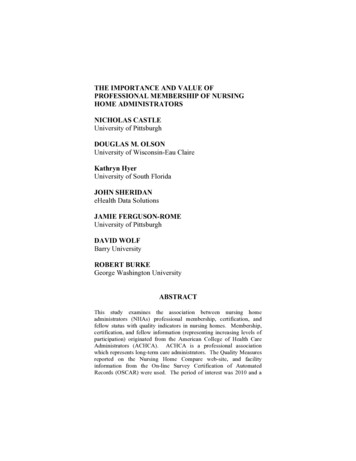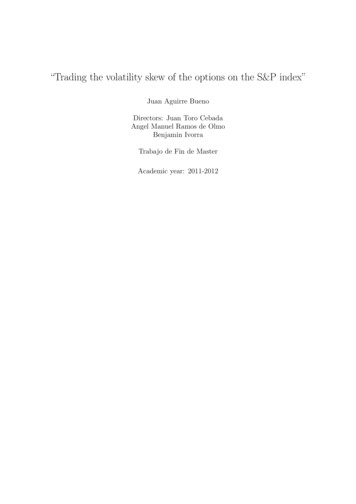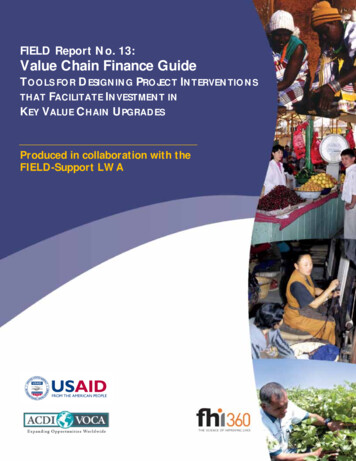
Transcription
!THE IMPORTANCE AND VALUE OFPROFESSIONAL MEMBERSHIP OF NURSINGHOME ADMINISTRATORSNICHOLAS CASTLEUniversity of PittsburghDOUGLAS M. OLSONUniversity of Wisconsin-Eau ClaireKathryn HyerUniversity of South FloridaJOHN SHERIDANeHealth Data SolutionsJAMIE FERGUSON-ROMEUniversity of PittsburghDAVID WOLFBarry UniversityROBERT BURKEGeorge Washington UniversityABSTRACTThis study examines the association between nursing homeadministrators (NHAs) professional membership, certification, andfellow status with quality indicators in nursing homes. Membership,certification, and fellow information (representing increasing levels ofparticipation) originated from the American College of Health CareAdministrators (ACHCA). ACHCA is a professional associationwhich represents long-term care administrators. The Quality Measuresreported on the Nursing Home Compare web-site, and facilityinformation from the On-line Survey Certification of AutomatedRecords (OSCAR) were used. The period of interest was 2010 and a!
538JHHSA SPRING 2015total of 19 quality indicators were examined. Data were analyzedthrough multivariate analyses using negative binomial regression. Theresults indicate NHAs who are members of ACHCA are associatedwith better quality in 6 of the 19 quality indicators examined; ACHCAcertified member fellows are associated with better quality in 7 of the19 quality indicators examined; ACHCA fellows are associated withbetter quality in 10 of the 19 quality indicators examined; and, ACHCAmembers (excluding certified, certified fellows, and fellows) areassociated with better quality in 13 of the 19 quality indicatorsexamined.These findings support the value of professionalmembership, as well as voluntary certification or fellow credentialingof NHAs with respect to quality improvement.Key words: certification, fellow, nursing homes, quality improvement,professional membershipINTRODUCTIONWing and Salsberg (2001) stated, “Nursing homeadministrators play a central role in the quality of life ofnursing home residents in the U.S.” Nursing homeadministrators (NHAs) are required to perform a multitudeof work duties, many of which are vital components to thedaily operations and quality of care in nursing homes. Inaddition, the demands placed on the long-term careadministrator have significantly increased over the last 40years (Pratt, 2010). As such, the education, training, andguidance given to NHAs may be extremely importantcomponents in helping hone the skills needed to conductthe daily operations and promote quality of care in nursinghomes. In the research presented here, the association ofthe American College of Health Care Administrators(ACHCA) membership, nursing home administratorcertification (CNHA), and Fellow status are examined inrelation to quality of care.Studies show that NHAs play a part in the lives of!
JHHSA SPRING 2015539!the residents and the care they receive (Castle, Ferguson, &Hughes, 2009). In many nursing homes, the dailyoperations are executed under the direction of the topmanagement team, typically consisting of a NHA and aDirector of Nursing (DON). The top management team ineach nursing home may operate differently from eachother, but they all are responsible for the budget, stafftraining, overseeing quality programs, safety, and severalother tasks (Wagner, McDonald, & Castle, 2012). All ofwhich have the potential to influence the quality of careresidents receive.In a white paper commissioned by ACHCA and theNAB Foundation, Effective Leadership in Long Term Care:The Need and Opportunity, Dana and Olson (2007)discussed and reviewed the importance and uniqueness ofthe important role of leadership in the field of long-termcare. This reflects the long held notion that top managershave a crucial impact on organizations (Thomas, 1988).Top managers influence profitability (Keller, 2006), cancreate or transform cultures (Hatch, 2000), and can promoteeffective or high-quality services (Rousseau, 2006) – toname just three.ACHCA (The American College of Health CareAdministrators) was established in 1962 and “is a achca.org) for administrators of assisted living, postacute, and skilled nursing facilities. The Institute forCredentialing Excellence (ICE) defines professionalcertification as “a voluntary process by which a nongovernmental entity grants a time-limited recognition anduse of a credential to an individual after verifying that he orshe has met predetermined and standardized criteria. It is avehicle that a profession or occupation uses to differentiateamong its members, using standards, sometimes developedthrough a consensus-driven process, based on existing legaland psychometric requirements” (2009, p.6).!!
540JHHSA SPRING 2015ACHCA provides members with educationalopportunities, certification possibilities, and careerdevelopment. The ACHCA certification program requiresthe applicant to meet both educational and experientialqualifications for eligibility, as well as to pass a test thatdemonstrates performance at an advanced level of skill andknowledge.In this research, ACHCA membership,certification, Fellow, and a combination of membership,certification, and Fellow status are examined.ACHCA members are long-term care administratorswho pay ACHCA’s full membership fee. The certificationprocess began in 1978 and requires that the licensedadministrator pass the CNHA exam, have two yearsexperience as a practicing administrator, have 40continuing education (CE) hours completed, as well asother educational, experience, and career developmentrequirements (Castle & Fogel, 2001). To become anACHCA Fellow an applicant must be a full member for atleast two years immediately prior to application andcomplete at least four years of education beyond highschool. Furthermore, the applicant must give evidence ofservice beyond the ordinary demands of the administratorposition to both the community and to the long-term carefield. ACHCA rates the experience, education, and serviceof each Fellow applicant based on a specific scoringsystem.To become a Fellow, an applicant mustaccumulate 165 points on the Fellow application. CertifiedFellows are ACHCA members who hold both the Fellowand certified credential.These four levels of membership representincreasing levels of exposure and participation in ACHCA.That is a progression in exposure and participation frommembers, certified members, and fellows, to certifiedfellow members. Exposure and participation in ACHCAincludes a variety of conference venues and educationalopportunities.!
JHHSA SPRING 2015541!Two major annual conferences are held for generalmembership and a Summer Leadership Conference whichtargets certified members, fellows, and certified fellowmembers are provided. ACHCA offers CE throughapproved online learning for all of the general membership.Furthermore, a selection of print-based educational materialis offered as well as self-studies based on relevantleadership related texts. An online support system alsooffers members advice and support. However, it is notedthat this current research study is cross sectional and, assuch, the findings may not be causally related to ACHCA’seducational or other offerings.Prior research has shown there is a relationshipbetween quality of care and NHAs who are members ofACHCA (Castle & Fogel, 2001). This prior study foundthat nursing homes with an ACHCA administrator hadsignificantly lower numbers of health-related deficiencies(1.4 fewer). Furthermore, the study found that 29.6% ofsuch facilities had no health-related deficiencies (Castle &Fogel, 2001). The study suggested that facilities withACHCA administrators “do better because they have betterleadership” (Castle & Fogel, 2001, p.15). Results alsoshowed that facilities with ACHCA members who werealso certified administrators had an even higher quality ofcare than facilities managed by an ACHCA member, alone.That is, 40% of the facilities managed by ACHCAmembers who were certified, had no health-relateddeficiencies; roughly 29% of facilities were restraint-free;and, approximately 28% of facilities were pressure ulcerfree (Castle & Fogel, 2001).No other studies were identified that examinedcertification of NHAs. Rowland, Cowles, Dickstein, andKatz (2009) examined the impact of medical directorcertification on nursing home quality. They found apositive association between certification and overallquality.!!
542JHHSA SPRING 2015The prior research by Castle and Fogel used datafrom 1998. Thus, the information is now somewhat dated.Moreover, the nursing home industry has changedconsiderably in the intervening years.The currentchallenges NHAs face potentially make associationmembership and credentialing ever more pertinent. Thecurrent challenges NHAs face include increasedcompetition from other providers such as assisted living; asicker resident population; increased regulation; processinnovations such as culture change; and, relatively lowerlevels of reimbursement (to name just five). Thus, theresearch presented here updates this prior work. Followingthis prior research we propose that (1) professionalmembership will be associated with high quality of care;and, (2) a progression in professional membership (i.e.,members, certified members, fellows, certified fellows)will be associated with a progression of high quality ofcare.METHODSPrimary DataACHCA 2010 member status (members, certifiedmembers, fellows, and certified fellow members) wasidentified from the 2010 ACHCA member master list(dated January 3, 2011). All other variables used (seebelow) were collected to match this time period. .Members are NHAs who pay ACHCA’s fullmembership fee. Certified members have passed theCNHA exam, have two years experience as a practicingadministrator, and have 40 CE hours completed. Fellowsare ACHCA members for at least two years, have at leastfour years of education beyond high school, and haveprovided service to both the community and to the longterm care field. Certified Fellows are members who holdboth the fellow and certified credential.!
JHHSA SPRING 2015543!The sample examined in this research did notinclude the following types of membership: student,associate, bridge, retired, and retired fellow. In addition,educators and government employees were removed fromthe membership sample. The list was also purged ofduplicates, leaving only practicing NHAs on the list. If anindividual was an administrator for multiple facilities, onlythe facility listed first alphabetically was selected forinclusion in the study. Then, this list was merged with alist of nursing homes for which quality measures wereavailable from Nursing Home Compare (described below).Lists were matched by facility name and state.Secondary DataValue data. Several quality indicators for theanalyses used came from Nursing Home pare is a web-based report card providing informationfor all Medicare and/or Medicaid certified nursing homes.This data includes a series of Quality Measures. TheNursing Home Compare Quality Measures used in thisanalysis came from eHealth Data Solutions (ehds.com) whoclean the data and compute Quality Measure percentiles(see below) for commercial use in the Value Data initiative(an initiative promoting quality improvement in nursinghomes).The Quality Measures reported are advantageous inseveral respects. They were subject to extensive testing,are derived from the Minimum Data Set (MDS), are readilyavailable, and represent measures relevant to bothconsumers and providers (Abt Associates Inc., 2004).Moreover, the Quality Measures are becoming commonlyused in empirical research (e.g., Alexander, 2008).The Quality Measures used in the Value Data arefrom the MDS National Quality Indicator System for theThird Quarter of 2010. The information in this data!!
544JHHSA SPRING 2015represents the time period of April through June 2010which matches the time period of the 2010 ACHCAmember master list.The Quality Measure data provides the percentageof residents who trigger the measure(s) during the quarter.These data are used at the State level to target survey andquality monitoring activities. The Quality Measure dataincludes all nursing home residents in a given state. Thisdata is also supplemented by Quality Indicator data for useby the survey and quality monitoring activities.On-line Survey Certification of Automated Records(OSCAR). As part of state/federal annual nursing homeinspection, surveyors record many characteristics of thenursing home (e.g., number of beds) and aggregatecharacteristics of residents (e.g., number with dementia).Facilities that accept residents with Medicare and/orMedicaid payments (97% of US nursing homes) aresurveyed and these facility characteristics were matched tothe ACHCA members. , The data are commonly used as asecondary source of nursing home characteristics (e.g.,Decker, 2008).Quality IndicatorsQuality measures. At the time period of dataavailability for this study (i.e., 2010) CMS reported on 19measures – these are called the core Quality Measures. TheQuality Measures address specific areas of resident care, 5are for short-stay residents and 14 are for long-stayresidents. Long-stay measures are for those residentsstaying at a facility 3 months or more and short-staymeasures are for residents staying at a facility less than 3months.The long-stay measures are, the percent ofresidents: whose need for help with daily activitiesincreased; with moderate to severe pain; at high-riskresident with pressure sores; at low-risk residents with!
JHHSA SPRING 2015545!pressure sores; with physical restraint use; more depressedor anxious; at low-risk residents with loss of bladder orbowel control; who had a catheter inserted and left inbladder; who spend most time in bed or in a chair; whoseability to move in/around room got worse. The short-staymeasures are, the percent of residents: with delirium; withmoderate to severe pain; and, with pressure sores.The Quality Measures contained in Medicare.govwere used as percentiles in this research. Residentstriggering the short-stay or long-stay measures wereselected as the numerator. The denominator is defined bythe count of those residents who have the necessary recordsand applicable clinical status to be available for inclusion inthe Quality Measure calculation. A fraction is made byapplying the numerators and denominators, and this isexpressed as a percent ratio that normalizes for facilitieswith different resident census.Independent VariablesTable 1 lists the facility characteristic variables thatwere used in this analysis as independent variables. Thevariables included in the analyses were derived from theprior research in this area that examined nursing homequality (e.g., Castle & Engberg, 2008; Decker, 2008).Facility characteristic variables included in thisresearch are size, chain membership, ownership, occupancyrate, nurse staffing measures, Medicaid resident occupancy,private-pay occupancy, and resident case-mix. The numberof nursing home beds was used as a measure of size. Twoclasses of facility ownership were used, for-profit and notfor-profit.Two classes of multi-facility corporationmembership were used, chain and non-chain. The overalloccupancy rate is the percent of beds occupied by residents.The percent of residents paid for by Medicaid or privatepay were used as measures of Medicaid resident occupancyand private-pay resident occupancy respectively.!!
546JHHSA SPRING 2015Three different types of nursing staff were includedin the analyses: the number (measured as Full TimeEquivalent [FTE]) of RNs, LPNs, and nursing assistants per100 beds. An average Activities of Daily Living (ADL)score was used to represent case-mix. For each of threeADL questions (eating, toileting, and transferring) in theOSCAR, a score from 0 to 3 was used by using noassistance, moderate need for assistance, and high degree ofneed for assistance, respectively. We then calculated thesescores, with higher scores indicating a greater average ADLimpairment within the facility.!
JHHSA SPRING 2015547!Table 1:Descriptive Statistics of Certification Type for NursingHome Administrators and Nursing Home CharacteristicsCertifiedMean(or %)N 58ACHCA Credential TypeCertifiedFellowMemberFellowMeanMeanMean(or %)(or %)(or %)N 60N 129N 649All OtherFacilitiesMean(or %)N 14,221Size (number130140172135108of 57%69%ownershipOccupancy86%86%88%89%83%rateNurse aide0.070.060.070.060.06staffing(FTEs perresident)LPN staffing0.140.150.110.130.14(FTEs perresident)RN staffing0.370.410.370.370.37(FTEs ent0.190.220.210.220.21case-mix(ADL score)ACHCA American College of Health Care Administrators; RN RegisteredNurse; LPN Licensed Practical Nurse; FTE Full time-equivalent; ADL Activities of Daily Living.Members NHAs who pay ACHCA’s full membership fee; Certified members passed the CNHA exam, have two years experience as a practicingadministrator, and have 40 CE hours completed; Fellows ACHCA membersfor at least two years, have at least four years of education beyond high school,and have provided service to both the community and to the long-term carefield; Certified Fellow ACHCA members who hold both the fellow andcertified credential.!!
548JHHSA SPRING 2015ANALYSESDescriptive statistics (means and standarddeviations) for the quality of care variables of interest, andfor the organizational control variables (means, standarddeviations, and percents) are presented in Table 2.We examined the level of collinearity among theindependent variables and multicollinearity, by using thevariance inflation factor (VIF) test. The correlationbetween the variables was generally low.Negative binomial regression was used inmultivariate analyses to examine the association ofACHCA membership, certification, and Fellow status withthe quality indicators (Table 3). The quality indicators arepercentiles of specific negative events per nursing home.For many facilities, these counts were low or zero.Negative binomial regression is based on a generalizationof the Poisson distribution that can account for the skewednature of data.This allows for more unmeasuredheterogeneity among the observations in the sample, which,can be manifested when several observations have low orzero events (Gardner, Mulvey, & Shaw, 1995). Thecoefficients are reported in incident-rate ratio form, whichis similar to odds ratios; that is, estimates greater than onerepresent a positive association between the explanatoryvariable and the outcome. High values of the qualityindicators are associated with lower quality because theyindicate a high percentage of residents with the specifiednegative outcome; thus, coefficients less than one arerepresentative of better quality.!
JHHSA SPRING 2015549!Table 2:Descriptive Statistics by Certification Type for QualityIndicators Variables ExaminedCertified Certified Fellow Member All Other FacilitiesMeanFellow MeanMeanMean(or %)Mean (or %) (or %)(or %)(or %)N 58N 60 N 129 N 649 N 14,221Long Stay Measures 1. ADL worse2. Pain3. Pressure ulcer high risk4. Pressure ulcer low risk5. Restraints6. Incontinence low risk7. Catheter8. Bed or chair9. Mobility worse10. UTI11. Mood12. Weight loss13. Flu shot14. Pneumococcal 640.0543.0943.4640.3138.07Short Stay Measures 15. Delirium16. Pain17. Pressure ulcer18. Flu shot19. Pneumococcal vaccination Definitions can be found in Abt (2004).Members NHAs who pay ACHCA’s full membership fee; Certified members passed the CNHA exam, have two years experience as a practicingadministrator, and have 40 CE hours completed; Fellows ACHCA membersfor at least two years, have at least four years of education beyond high school,and have provided service to both the community and to the long-term carefield; Certified Fellow ACHCA members who hold both the fellow andcertified credential.!!
550JHHSA SPRING 2015Table 3:Regression Coefficients for the Effects of Certification onNursing Home Quality ellow mberVs.NoACHCAAffiliationLong Stay Measures0.91*0.90*0.89***0.88***2. Pain0.98*0.960.990.96**3. Pressure ulcer high risk0.950.981.011.034. Pressure ulcer low risk0.950.971.030.955. Restraints0.90*0.900.96*0.87**6. Incontinence low risk0.85*0.89*0.980.85**7. Catheter0.980.990.95*0.94***8. Bed or chair0.970.93**0.97**0.96**9. Mobility worse1.010.990.990.9910. UTI1.040.980.970.79***11. Mood0.96*0.94*0.96*0.94*12. Weight loss0.971.011.041.0913. Flu shot0.990.980.93***0.86***14. Pneumococcal vaccination0.980.81**0.91**0.82***15. Delirium1.030.980.990.9916. Pain0.97*0.96*0.95**0.95**17. Pressure ulcer0.930.890.881.0118. Flu shot0.970.950.94**0.89***19. Pneumococcal vaccination0.880.89**0.92***0.95***1. ADL worseShort Stay MeasuresNotes: (1) Information from 27 regression analyses are presented,representing one regression model for each quality indicator of interest.In the rows the incident-rate ratio for negative binomial regressions arepresented (2) Regression coefficients for the quality indicators ofinterest are presented for parsimony; all variables in Table 1 with theaddition of state dummies were also included in each model (results for!
JHHSA SPRING 2015551!all variables in the models included in Table 3 are available from theauthors).*p .05; **p .01; ***p .001. Outcome variables were all coded so that lower scores representbetter quality.ACHCA American College of Health Care Administrators; ADL Activities of Daily Living.Members NHAs who pay ACHCA’s full membership fee; Certifiedmembers passed the CNHA exam, have two years experience as apracticing administrator, and have 40 CE hours completed; Fellows ACHCA members for at least two years, have at least four years ofeducation beyond high school, and have provided service to both thecommunity and to the long-term care field; Certified Fellow ACHCAmembers who hold both the fellow and certified credential.In order to account for possible correlation of outcomeswithin markets, which can bias the standard errors of theestimates, the Huber-White sandwich estimator (i.e., robuststandard errors) clustered by county was also used for all ofthe multivariate analyses (Zeger & Liang, 1992).RESULTSThe sample consisted of 58 Certified members, 60Certified Fellow members, 129 Fellows, and 649 Members.The comparison group for the analyses consisted of 14,221other facilities.As shown in Table 1, ACHCA members tend towork in larger facilities, and are less likely to be in chainfacilities. However, characteristics such as private-payresident occupancy and resident case-mix areapproximately equal across all types of ACHCA membersand all other facilities (i.e., non-members).The results of the regression analyses are displayedin Table 3. For parsimony, the regression coefficients forthe independent variables of interest are presented (i.e.,Certified, Certified and Fellow, Fellow, Member).However, all variables in Table 2 were included in each!!
552JHHSA SPRING 2015regression model (results for all variables in the models areavailable from the authors). In summary, for these otherindependent variables several staffing characteristicvariables (i.e., higher nursing assistant staffing levels in 24of 27 cases and higher RN staffing levels in 21 of 27 casesassociated with high quality) were statistically significant(p .05) and several facility characteristic variables (i.e.,not-for-profit in 17 of 27 cases and high private-pay in 22of 27 cases associated with high quality) were statisticallysignificant (p .05). Such findings are often identified innursing home quality research, and provide some facevalidity to the findings in general.ACHCA certified membership is associated withbetter quality in 6 of the 19 quality indicators examined.For example, the risk of incontinence (in low risk residents)is 15% lower in ACHCA certified (p .05) facilitiescompared to those with no ACHCA affiliation. ACHCAcertified member fellows are associated with better qualityin 7 of the 19 quality indicators examined. For example,the receipt of pneumococcal vaccination is 19% higher inACHCA certified (p .01) facilities compared to thosewith no ACHCA affiliation.ACHCA Fellows areassociated with better quality in 10 of the 19 qualityindicators examined. For example, the risk of ADL declineis 11% lower in ACHCA certified (p .001) facilitiescompared to those with no ACHCA affiliation. ACHCAmembers (excluding certified administrators, certifiedFellows, and Fellows) are associated with better quality in13 of the 19 quality indicators examined. For example, therisk of a UTI is 21% lower in ACHCA certified (p .01)facilities compared to those with no ACHCA affiliation.DISCUSSIONOur results support prior research that shows theimportant impact NHAs can have on nursing homes and!
JHHSA SPRING 2015553!seem to indicate that professional membership could likewisebe important in influencing NHAs ultimately supportingthese type of positive practices.In this study, ACHCA certified membership isassociated with better quality in 6 of the 19 qualityindicators examined; ACHCA certified member fellows areassociated with better quality in 7 of the 19 qualityindicators examined; ACHCA Fellows are associated withbetter quality in 10 of the 19 quality indicators examined;and, ACHCA members (excluding certified administrators,certified Fellows, and Fellows) are associated with betterquality in 13 of the 19 quality indicators examined. Thesefindings would appear to be important and operationallysignificant (as well as statistically significant).If the percentile differences in the Quality Measuresare compared, then facilities with an ACHCA administratorhave better overall quality. Using a 100 bed facility as anexample (and controlling for resident case-mix, etc.),ACHCA membership is associated with residents with 42fewer quality issues than non ACHCA membership. Thus,the findings would appear to have both practical andstatistical significance.A survey examining how much time NHAs devotedto different activities (Castle, Ferguson, & Hughes, 2009)showed that NHAs believe that their time is spent dealingwith external regulation and accreditation (17%), problemmanagement with staff and family (12% and 9%), andacquisitions with current vendors (8%), as the top four timeintensive activities. Very little time is spent directlyaddressing quality of care (i.e., quality assurance practicesare listed as 4% of time and resident care policies andpractices as 8%). We propose that one benefit of ACHCAmembership is the ability to address these tasks such thatmore time can be devoted to leadership practices thatinfluence quality of care. For example, ACHCA providesleadership and management education through its!!
554JHHSA SPRING 2015conferences and webinars. In addition, ACHCA membershave the opportunity to consult with other membersthrough its online membership network. However, clearlymore research needs to be done to examine the operationalimpact of ACHCA membership.This information is potentially important.Ifprofessional membership (such as with ACHCA) wasfurther promoted and expanded, this could be a relativelyinexpensive means of improving the quality of care innursing homes. Moreover, administrators’ professionalmembership could be featured on web-sites such asNursing Home Compare. If NHAs who are members ofACHCA provide better quality (or better management) thanNHA’s without the credentialing, families choosing anursing home may find this information valuable. It mayalso become important to organizations such as managedcare providers who may offer less stringent qualifyingparameters to facilities who have ACHCA administratorsor possibly accrediting bodies such as the JointCommission, a voluntary accrediting body whose standardsfor quality of care include education and training level ofadministrators.The four levels of membership examinedrepresented increasing levels of exposure and participationin ACHCA. As such, we expected that NHAs with themost amount of involvement with ACHCA would beassociated with the highest performance. We found alllevels of membership were beneficial; however, contrary toour expectation NHAs with the least amount ofinvolvement with ACHCA (membership only) wereassociated with the highest performance. Thus, ourfindings identify that professional membership (at alllevels) is associated with better quality; however, the finerdistinction of additional benefits of increasing levels ofmembership was not substantiated.ACHCA membership provides needed training!
JHHSA SPRING 2015555!materials and mentorship. However, we were not able toexamine how ACHCA membership improves quality ofcare.Some recent research has examined NHAcharacteristics believed to promote success in the industry(Siegel et al., in press). This may help explain ourunexpected finding. Further examining these factors is aneeded next step for research.LIMITATIONSOne area not addressed in this research or priorresearch, because of reliance on cross-sectional data, is thecausal influence of ACHCA membership on quality ofcare. Nursing homes with more favorable outcomes mayhire or attract the most talented top managers, rather thanvice versa. With cross-sectional data, we cannot di
nursing home residents in the U.S.Ó Nursing home administrators (NHAs) are re quired to perform a multitude of work duties, many of which are vital components to the daily operations and quality of care in nursing homes. In addition, the demands placed on the long -term care











